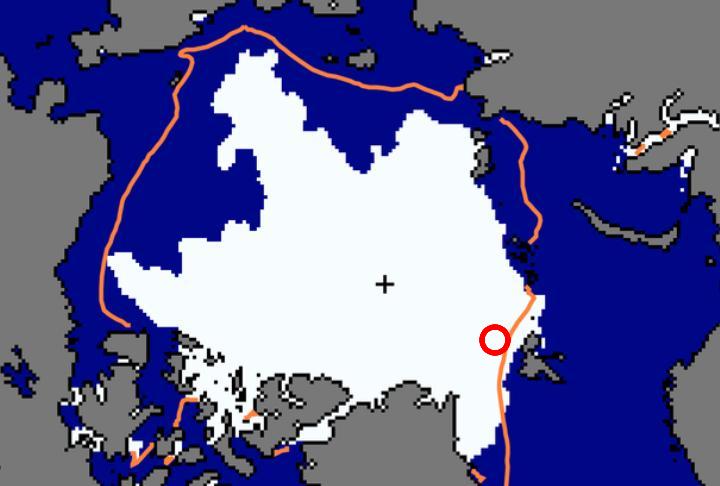From the Monthly Weather Review : November, 1922
In August, 1922, the Norwegian Department of Commerce sent an expedition to Spitzbergen and Bear Island under the leadership of Dr. Adolf Hoel, lecturer on geology at the University of Christiania.
Ice conditions were exceptional. In fact, so little ice has never before been noted. The expedition all but established a record, sailing as far north as 81º 29′ in ice-free water.
81º 29′ is shown on the map above as a red circle. There is more ice now in that part of the Arctic than there was in 1922.
Formerly the waters around Spitzbergen held an even summer temperature of about 3º Celsius; this year recorded temperatures up to 15º, and last winter the ocean did not freeze over on the north coast of Spitzbergen.
Nobody was arrogant or foolish enough in 1922 to blame the weather on human activity, other than a few religious fanatics.



The retread of Arctic sea ice was succeeded by an extraordinary extended sea ice during summer 1917 http://www.arctic-warming.com/hottopics/20100130/indian-drought-1918-north-atlantic_clip_image020.jpg , which seem to have been the only one that occurred so late in summer during the last century, and a very pronounced warm winter at Spitsbergen 1918/19, http://www.arctic-warming.com/hottopics/20100130/indian-drought-1918-north-atlantic_clip_image026.jpg , starting a two decade warming lasting until winter 1939/40.
The reasons for the exceptional sea ice conditions in 1922 were laid in winter 1918/19, or already in summer 1917, by a huge influx of fresh water from melting sea ice. What was the cause for this two events? My recent book “Arctic Heats Up – Spitsbergen 1919-1939”, http://www.arctic-heats-up.com/ explains that a link to naval activities during WWI 1914-1918 is possible. Any better explanation is most welcome. The developments of the Arctic sea ice conditions during the last decade would be better understood if more attention and reasoning had been directed to the early Arctic warming 1919-1939 .
I wish people would stop trying to sail around the Arctic ocean. I feel it messes with the ice, especially when they have to bring in Ice Breakers to free the people who’ve tried to do it.
With regard to the sea temperature and salinity structure there is no sea as fragile and sensitive on Earth as the Arctic Ocean, http://www.arctic-heats-up.com/pdf/7_1.pdf, and any human activities (e.g. research vessels, submarines, etc.) may have a great effect, particularly when operating in sea ice covered areas.
temperatures up to 15º
Was there a super-super El Nino just before than that sent a lot of heat there?
# El Nino & 1922
Ocean regions and corners are everywhere around the globe and not only in equatorial Pacific. Even a strong El Nino is a very short lasting event, while the Artic warming from 1919 to 1939 required a sustained source, not difficult to identify as the West Spitsbergen Current, carrying warm water from the Gulf Stream to the Arctic basin. See Chapter 7: “Where did the early Arctic Warming originate?” http://www.arctic-heats-up.com/chapter_7.html
Knut Aagard (1982): “It may well be, for example that in the long run the Eskimos in Alaska will care considerably what the European puts into the Irish Sea.”.
1922, 1957…….
http://www.youtube.com/watch?v=OcHtaX87BTI
When Hoel sailed north of Spitzbergen in August 1922 he was clearly surprised to find it ice free at 81º 29?. These days it’s commonplace.
Since 1922 August ice has retreated north of 81º 29? at 18º E (the longitude of Spitzbergen) in 1960, 1970, 1974, 1976, 1984, 1985, 1997, 1998, 1999, 2001, 2002.
The National Snow & Ice Data Center ice edge data I looked at doesn’t proceed past 2002, but given the sharp decline in arctic sea ice over the last 10 years I expect sea ice would have retreated north of 81º 29? at 18º E in most of the recent summers.
So I can’t see what is significant about 1922.